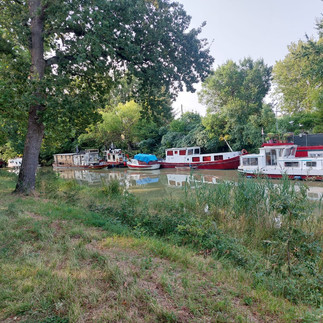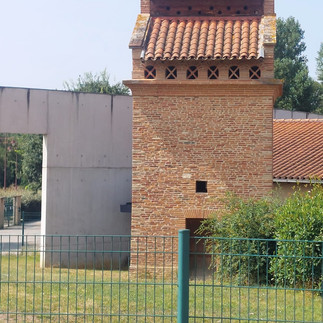Day 17: From Avignonet-Lauragais over Toulouse to l'Isle-Jourdain
- Magda Kirsch
- Aug 22, 2024
- 4 min read
During the night, I reviewed my route and realized that from the pilgrim house La Goutille (the droplet) run by Danielle, I could simply ride along the Canal du Midi all the way into the center of Toulouse. I can even continue from Toulouse along bike paths and greenways almost all the way to L'Isle-Jourdain, my next stop on the Via Tolosana. As always, I think it will be easy, but usually, the afternoon stretch becomes harder because I get tired and it gets too hot.
Leaving Danielle's gîte, view on the canal and the motorway and the church of Avignonet
Danielle lives in a small valley 3 to 4 km away from Avignonet, and I have to start my day by climbing steeply uphill for 500 meters. At the top, I stop, as there's a magnificent view of the Gothic church of Avignonet with its tall spire. Next to it, I see the railway, the highway, an old D road, and the Canal du Midi. All neatly lined up. I first pass by the Canal du Midi and resolutely head towards Toulouse. The Canal du Midi was built in the early 19th century by an engineer named Ruquier to quickly transport agricultural products to the big cities. The intention was also to create a connection between the Atlantic Ocean and the Mediterranean Sea via canals.
Cycling along the Canal du Midi
From Bordeaux to Toulouse, there's the Canal Latéral de la Garonne, and in Toulouse, at the Pont Jumeau, the Canal du Midi begins, leading to the Mediterranean Sea. In the late 19th and early 20th centuries, trains took over freight transport by water, followed later by road transport, marking the end of the canal as a means of freight transport. Since the 1960s, it has become a major tourist attraction, with many pleasure boats available for rent. Two major problems with this canal are: it requires an incredible amount of water to supply the locks, which is collected in the fall, winter, and spring in and around the Montagne Noire, where large reservoirs and dams have been built. The oldest is probably Lac de St. Féréol, which I passed by yesterday near Revel. The second problem is that from the mid-20th century, many of the beautiful trees along the canal began to die. A beetle had traveled with the Allied troops who landed in 1945 (France is commemorating this landing in Provence these days). Many trees died, but thanks to thorough research by universities, the problem was solved by planting a wider variety of trees. I have the impression that this rescue operation is succeeding.
Lac St Féréol, one of the rigolles and the houseboats
After cycling 40 km in the shade of the (new?) trees and beautiful nature, passing several locks, I reached the outskirts of Toulouse. The closer the canal gets to Toulouse, the more houseboats there are, where people live permanently. The canal runs right through the middle of the city, even next to the Gare Matabiau, the main station. Gradually, I saw more people cycling, alone or with children, etc. It's a real relaxation spot amidst greenery and water. Near the station, I took a short detour to the Basilique St. Sernin, one of the largest Romanesque pilgrimage churches, with a beautiful octagonal tower over the crossing. Built of red brick, like many churches in this area where hard stone was unavailable and too expensive to transport. The Place du Capitole is also worth a visit, along with the many small alleys around it, and the quays of the Garonne with lots of greenery. Toulouse is a pleasant (sometimes too warm) place full of life. Finally, I cycled past the Église des Jacobins, or the Dominican Church, with its palm-tree-like columns fanning out into elegant vaults.
Blagnac: The church and the Airbus site
Toulouse has it all: charm, cleanliness, friendliness, a pleasant atmosphere, and also, for cyclists: BIKE PATHS. There are beautiful bike paths everywhere, taking people in and around the city. I asked two locals for advice, and both gave me clear directions on how to leave Toulouse by bike and reach L'Isle-Jourdain on greenways or bike paths. Unbelievable but true. First, I followed a bike path along the Canal Latéral de la Garonne and then towards Blagnac to L'Isle-Jourdain. In Blagnac, Airbus planes are built, and there's a bike path that allows tourists to see all the types of planes made there. A test track can even be ridden like a greenway, resembling a major road for cycling.
In all the villages, you see many brick buildings; sometimes, all the buildings are red, with red paint over the bricks. In the last village before L'Isle-Jourdain, the town hall is made of red brick, as are the halls, the church, and the cobblestones in front of them.
Red brick buildings and the museum of modern art in L'isle Jourdain
In L'Isle-Jourdain, I'm staying in another municipal pilgrim gîte. There are three rooms with three beds each. There are four pilgrims, including myself, and I get a separate room from the others because two of them want to stay together. I quickly shower and explore the town. L'Isle-Jourdain, unfortunately, has nothing really interesting to offer, and the town is empty on Monday evening at 6 PM. I visit the St. Martin church, which is neo-classical from the 19th century; only the round tower remains Romanesque. A few old houses from the 18th century, etc., are okay but nothing special, and there's an old Romanesque bridge, the Pont Tourné, and that's about it. I quickly do some shopping for tonight and tomorrow and eat in the little kitchen of the pilgrim gîte, alone... the others are out or sleeping. Tomorrow, I continue following the Via Tolosana to Marciac, through the Gers, known for its rolling hills, which people here call toboggans. So, it will be a tough ride, covering nearly 100 km, but we'll see. I'm not too worried about it.
L'isle-Jourdain





































Comentários